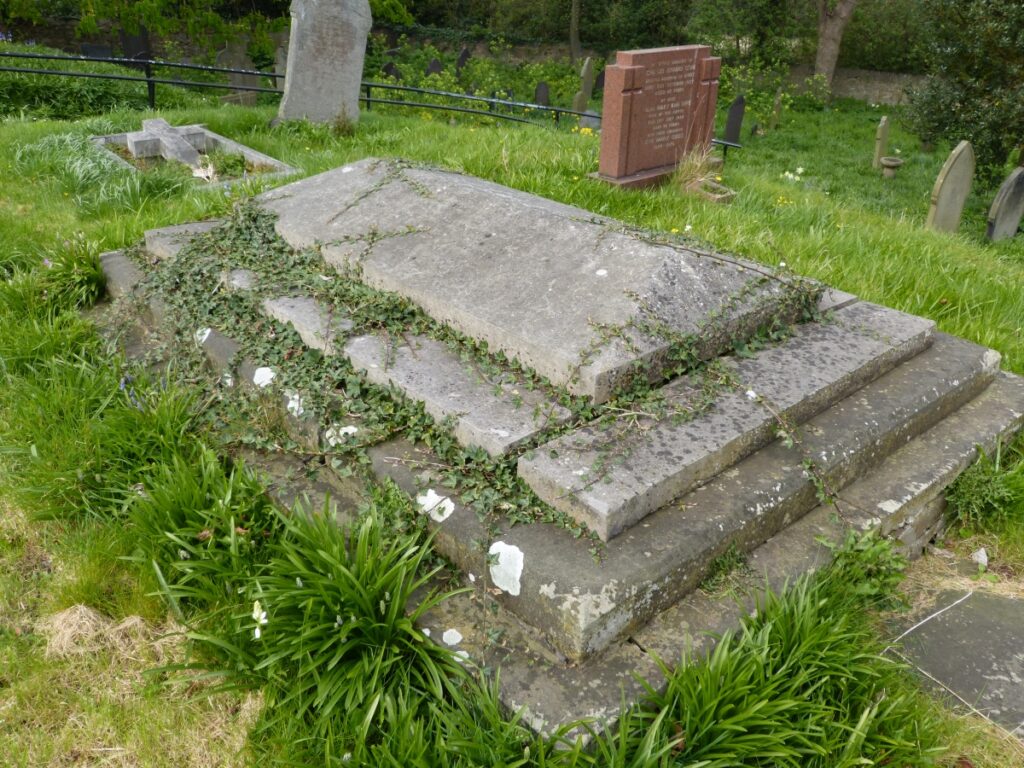Thomas Griffies-Dixon
Thomas Grifies-Dixon
By the 1850, the graveyard in Meliden was practically overflowing as the population increased to provide men for the booming Talargoch lead mine. The old circular graveyard was enclosed by a wall and space had run out—especially to the south, where the soil level had reached the bottom of the church windows. To the west lay the Tai Cochion Terrace, to the east was Melyd Lodge and the road to Prestatyn lay on the south boundary. Fortunately, the land to the north beneath the existing graveyard belonged to Thomas Griffies-Dixon who was willing to give it to the church a burial ground. The Bishop consecrated it in April 1862 and the first burial was in 1864.
Thomas Griffies-Dixon is a forgotten man. There are no roads, avenues, crescents or housing estates named after him and his tomb is not nearly so impressive as John Dawson’s—but it does have a much better view! On a slight mound, it consists of three stone slabs in layers—like a very flattened pyramid covered in ivy. Born in 1820, he could best be described as a Lancashire Country Gentleman who married carefully and occupied a succession of estates which he managed himself. He arrived in this area after purchasing Nant Hall and parts of the estate in 1857. He was a social climber and eventually became the chief magistrate for Prestatyn and Rhyl. He was the High Sheriff of Flintshire in 1873, for many years the chairman of the workhouse Board of Guardians and he chased foxes in his spare time.
By July 1887 he owed £47,460 (almost £5 million today) having lost heavily on the Nant Estate because of the bad times in agriculture. There was a family of seven to support which he did in style. At the Bangor Court hearing, he claimed that the expense of a staff of six which comprised of a governess, cook, lady’s maid, laundry maid, housemaid and under-housemaid had ruined him. He admitted that he had lived on his father’s money and had no profession or trade but owned the Littleton Estate in Cheshire and had shares in various companies. The problems had started back in 1860 when he invested in a Scottish insurance company which had gone to the wall. He had been taken to court and lost but then then he went before the Master of Rolls and won. The other side took it to the Lords Justice of Appeal and they decided against him. Finally, it went to the House of Lords and he won but it had cost him £5,000 in legal fees (£425,000 now).
After a further examination in the Chester Bankruptcy Court at the end of 1887 it was discovered that Thomas Dixon’s assets could cover his debts and he was discharged. The Official Receiver was persuaded to grant him a certificate which stated that “the that the bankruptcy was caused by misfortune, without any misconduct on the part of the bankrupt.” That certificate also enabled him to resume his duties as a magistrate. He had survived by the skin of his teeth but the affair undermined his his position in local society. In 1889 the lease of Nant Hall was taken over by a Formby businessman and converted to a first class hotel. Thomas Dixon gave up all his civic duties—he was seventy after all—and left Prestatyn to live in Dolben, a mansion near Cefn and then, finally, at Plas Elwy in St. Asaph where he died in 1899 aged eighty.

Thomas Grifies-Dixon grave in the graveyard of St. Melyd Church
